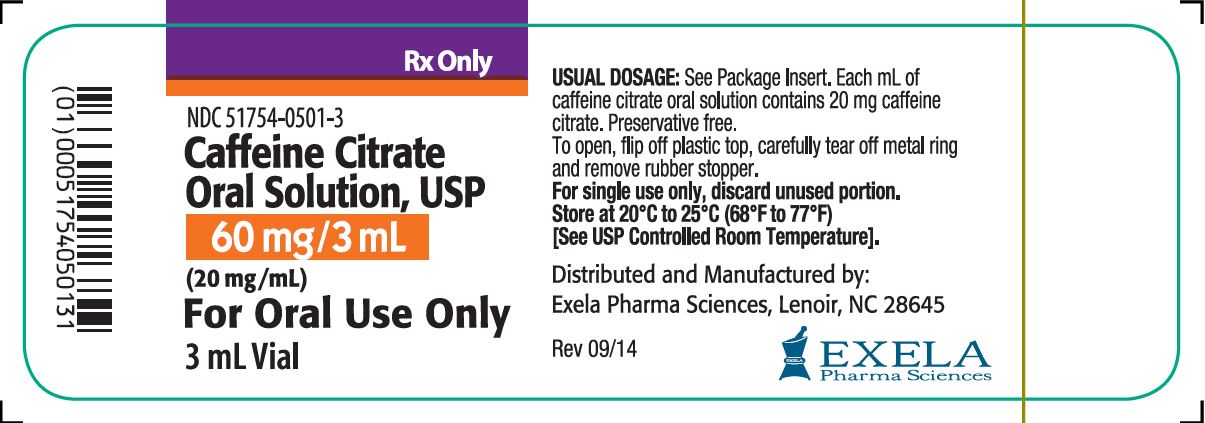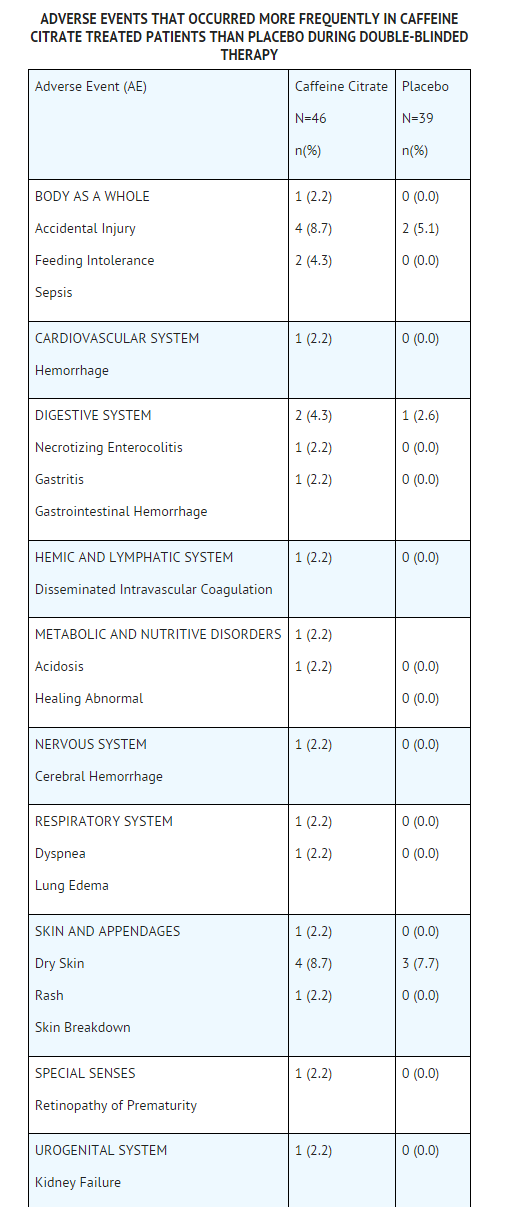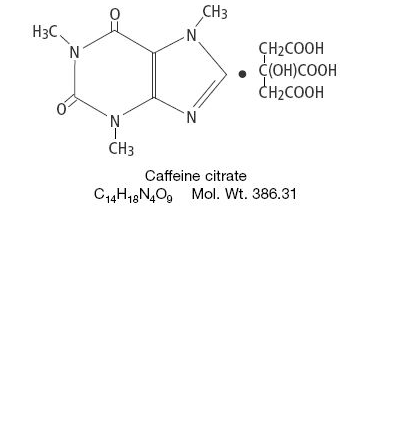Caffeine citrate (oral)
Editor-In-Chief: C. Michael Gibson, M.S., M.D. [1]; Associate Editor(s)-in-Chief: Ammu Susheela, M.D. [2]
Disclaimer
WikiDoc MAKES NO GUARANTEE OF VALIDITY. WikiDoc is not a professional health care provider, nor is it a suitable replacement for a licensed healthcare provider. WikiDoc is intended to be an educational tool, not a tool for any form of healthcare delivery. The educational content on WikiDoc drug pages is based upon the FDA package insert, National Library of Medicine content and practice guidelines / consensus statements. WikiDoc does not promote the administration of any medication or device that is not consistent with its labeling. Please read our full disclaimer here.
Overview
Caffeine citrate (oral) is a methylxanthine that is FDA approved for the treatment of apnea of prematurity in infants between 28 and <33 weeks gestational age. Common adverse reactions include irritability, feeding problem.
Adult Indications and Dosage
FDA-Labeled Indications and Dosage (Adult)
There is limited information regarding FDA-Label Guideline-Supported Use of Caffeine citrate (oral) in adult patients.
Off-Label Use and Dosage (Adult)
Guideline-Supported Use
There is limited information regarding Off-Label Guideline-Supported Use of Caffeine citrate (oral) in adult patients.
Non–Guideline-Supported Use
There is limited information regarding Off-Label Non–Guideline-Supported Use of Caffeine citrate (oral) in adult patients.
Pediatric Indications and Dosage
FDA-Labeled Indications and Dosage (Pediatric)
Indication
- Caffeine citrate injection and caffeine citrate oral solution are indicated for the short term treatment of apnea of prematurity in infants between 28 and <33 weeks gestational age.
Dosage
- Prior to initiation of caffeine citrate, baseline serum levels of caffeine should be measured in infants previously treated with theophylline, since preterm infants metabolize theophylline to caffeine. Likewise, baseline serum levels of caffeine should be measured in infants born to mothers who consumed caffeine prior to delivery, since caffeine readily crosses the placenta.
- The recommended loading dose and maintenance doses of caffeine citrate follow.
- NOTE THAT THE DOSE OF CAFFEINE BASE IS ONE-HALF THE DOSE WHEN EXPRESSED AS CAFFEINE CITRATE (e.g., 20 mg of caffeine citrate is equivalent to 10 mg of caffeine base).
- Serum concentrations of caffeine may need to be monitored periodically throughout treatment to avoid toxicity. Serious toxicity has been associated with serum levels greater than 50 mg/L.
- Caffeine citrate injection and caffeine citrate oral solution should be inspected visually for particulate matter and discoloration prior to administration. Vials containing discolored solution or visible particulate matter should be discarded.
Off-Label Use and Dosage (Pediatric)
Guideline-Supported Use
There is limited information regarding Off-Label Guideline-Supported Use of Caffeine citrate (oral) in pediatric patients.
Non–Guideline-Supported Use
There is limited information regarding Off-Label Non–Guideline-Supported Use of Caffeine citrate (oral) in pediatric patients.
Contraindications
- Caffeine citrate injection and caffeine citrate oral solution are contraindicated in patients who have demonstrated hypersensitivity to any of its components.
Warnings
- During the double-blind, placebo-controlled clinical trial, six cases of necrotizing enterocolitis developed among the 85 infants studied (caffeine=46, placebo=39), with 3 cases resulting in death. Five of the six patients with necrotizing enterocolitis were randomized to or had been exposed to caffeine citrate.
- Reports in the published literature have raised a question regarding the possible association between the use of methylxanthines and development of necrotizing enterocolitis, although a causal relationship between methylxanthine use and necrotizing enterocolitis has not been established. Therefore, as with all preterm infants, patients being treated with caffeine citrate should be carefully monitored for the development of necrotizing enterocolitis.
Adverse Reactions
Clinical Trials Experience
- Overall, the reported number of adverse events in the double-blind period of the controlled trial was similar for the caffeine citrate and placebo groups. The following table shows adverse events that occurred in the double-blind period of the controlled trial and that were more frequent in caffeine citrate-treated patients than placebo.
- In addition to the cases above, three cases of necrotizing enterocolitis were diagnosed in patients receiving caffeine citrate during the open-label phase of the study.
- Three of the infants who developed necrotizing enterocolitis during the trial died.
- All had been exposed to caffeine. Two were randomized to caffeine, and one placebo patient was “rescued” with open-label caffeine for uncontrolled apnea.
Postmarketing Experience
- Adverse events described in the published literature include: central nervous system stimulation (ie, irritability, restlessness, jitteriness), cardiovascular effects (ie, tachycardia, increased left ventricular output, and increased stroke volume), gastrointestinal effects (ie, increased gastric aspirate, gastrointestinal intolerance), alterations in serum glucose (ie, hypoglycemia and hyperglycemia), and renal effects (increased urine flow rate, increased creatinine clearance, and increased sodium and calcium excretion). Published long-term follow-up studies have not shown caffeine to adversely affect neurological development or growth parameters.
Drug Interactions
- Cytochrome P450 1A2 (CYP1A2) is known to be the major enzyme involved in the metabolism of caffeine. Therefore, caffeine has the potential to interact with drugs that are substrates for CYP1A2, inhibit CYP1A2, or induce CYP1A2.
- Few data exist on drug interactions with caffeine in preterm neonates. Based on adult data, lower doses of caffeine may be needed following coadministration of drugs which are reported to decrease caffeine elimination (e.g., cimetidine and ketoconazole) and higher caffeine doses may be needed following coadministration of drugs that increase caffeine elimination (e.g., phenobarbital and phenytoin).
- Caffeine administered concurrently with ketoprofen reduced the urine volume in four healthy volunteers. The clinical significance of this interaction in preterm neonates is not known.
- Interconversion between caffeine and theophylline has been reported in preterm neonates. The concurrent use of these drugs is not recommended.
Use in Specific Populations
Pregnancy
- Concern for the teratogenicity of caffeine is not relevant when administered to infants. In studies performed in adult animals, caffeine (as caffeine base) administered to pregnant mice as sustained release pellets at 50 mg/kg (less than the maximum recommended intravenous loading dose for infants on a mg/m basis), during the period of organogenesis, caused a low incidence of cleft palate and exencephaly in the fetuses. There are no adequate and wellcontrolled studies in pregnant women.
- Australian Drug Evaluation Committee (ADEC) Pregnancy Category
There is no Australian Drug Evaluation Committee (ADEC) guidance on usage of Caffeine citrate (oral) in women who are pregnant.
Labor and Delivery
There is no FDA guidance on use of Caffeine citrate (oral) during labor and delivery.
Nursing Mothers
There is no FDA guidance on the use of Caffeine citrate (oral) with respect to nursing mothers.
Pediatric Use
There is no FDA guidance on the use of Caffeine citrate (oral) with respect to pediatric patients.
Geriatic Use
There is no FDA guidance on the use of Caffeine citrate (oral) with respect to geriatric patients.
Gender
There is no FDA guidance on the use of Caffeine citrate (oral) with respect to specific gender populations.
Race
There is no FDA guidance on the use of Caffeine citrate (oral) with respect to specific racial populations.
Renal Impairment
There is no FDA guidance on the use of Caffeine citrate (oral) in patients with renal impairment.
Hepatic Impairment
There is no FDA guidance on the use of Caffeine citrate (oral) in patients with hepatic impairment.
Females of Reproductive Potential and Males
There is no FDA guidance on the use of Caffeine citrate (oral) in women of reproductive potentials and males.
Immunocompromised Patients
There is no FDA guidance one the use of Caffeine citrate (oral) in patients who are immunocompromised.
Administration and Monitoring
Administration
Monitoring
There is limited information regarding Monitoring of Caffeine citrate (oral) in the drug label.
IV Compatibility
There is limited information regarding IV Compatibility of Caffeine citrate (oral) in the drug label.
Overdosage
There is limited information regarding Caffeine citrate (oral) overdosage. If you suspect drug poisoning or overdose, please contact the National Poison Help hotline (1-800-222-1222) immediately.
Pharmacology
There is limited information regarding Caffeine citrate (oral) Pharmacology in the drug label.
Mechanism of Action
- Caffeine is structurally related to other methylxanthines, theophylline, and theobromine. It is a bronchial smooth muscle relaxant, a CNS stimulant, a cardiac muscle stimulant, and a diuretic.
- Although the mechanism of action of caffeine in apnea of prematurity is not known, several mechanisms have been hypothesized. These include: (1) stimulation of the respiratory center, (2) increased minute ventilation, (3) decreased threshold to hypercapnia, (4) increased response to hypercapnia, (5) increased skeletal muscle tone, (6) decreased diaphragmatic fatigue, (7) increased metabolic rate, and (8) increased oxygen consumption.
- Most of these effects have been attributed to antagonism of adenosine receptors, both A and A subtypes, by caffeine, which has been demonstrated in receptor binding assays and observed at concentrations approximating those achieved therapeutically.
Structure
- Both caffeine citrate injection for intravenous administration and caffeine citrate oral solution are clear, colorless, sterile, non-pyrogenic, preservative-free, aqueous solutions adjusted to pH 4.7. Each mL contains 20 mg caffeine citrate (equivalent to 10 mg of caffeine base) prepared in solution by the addition of 10 mg caffeine anhydrous to 5.0 mg citric acid monohydrate, 8.3 mg sodium citrate dihydrate and Water for Injection.
- Caffeine, a central nervous system stimulant, is an odorless white crystalline powder or granule, with a bitter taste. It is sparingly soluble in water and ethanol at room temperature. The chemical name of caffeine is 3,7-dihydro-1,3,7- trimethyl-1H-purine-2,6-dione. In the presence of citric acid it forms caffeine citrate salt in solution. The structural formula and molecular weight of caffeine citrate follows.
Pharmacodynamics
There is limited information regarding Pharmacodynamics of Caffeine citrate (oral) in the drug label.
Pharmacokinetics
- Absorption: After oral administration of 10 mg caffeine base/kg to preterm neonates, the peak plasma level (Cmax) for caffeine ranged from 6-10 mg/L and the mean time to reach peak concentration (Tmax) ranged from 30 minutes to 2 hours. The Tmax was not affected by formula feeding. The absolute bioavailability, however, was not fully examined in preterm neonates.
- Distribution: Caffeine is rapidly distributed into the brain. Caffeine levels in the cerebrospinal fluid of preterm neonates approximate their plasma levels. The mean volume of distribution of caffeine in infants (0.8-0.9 L/kg) is slightly higher than that in adults (0.6 L/kg). Plasma protein binding data are not available for neonates or infants. In adults, the mean plasma protein binding in vitro is reported to be approximately 36%.
- Metabolism: Hepatic cytochrome P450 1A2 (CYP1A2) is involved in caffeine biotransformation. Caffeine metabolism in preterm neonates is limited due to their immature hepatic enzyme systems.
- Interconversion between caffeine and theophylline has been reported in preterm neonates; caffeine levels are approximately 25% of theophylline levels after theophylline administration and approximately 3-8% of caffeine administered would be expected to convert to theophylline.
- Elimination: In young infants, the elimination of caffeine is much slower than that in adults due to immature hepatic and/or renal function. Mean half-life (T ) and fraction excreted unchanged in urine (A of caffeine in infants have been shown to be inversely related to gestational/postconceptual age. In neonates, the T is approximately 3-4 days and the A is approximately 86% (within 6 days). By 9 months of age, the metabolism of caffeine approximates that seen in adults (T = 5 hours and A = 1%).
- Special Populations: Studies examining the pharmacokinetics of caffeine in neonates with hepatic or renal insufficiency have not been conducted. Caffeine citrate should be administered with caution in preterm neonates with impaired renal or hepatic function. Serum concentrations of caffeine should be monitored and dose administration of caffeine citrate should be adjusted to avoid toxicity in this population.
Nonclinical Toxicology
There is limited information regarding Nonclinical Toxicology of Caffeine citrate (oral) in the drug label.
Clinical Studies
- One multicenter, randomized, double-blind trial compared caffeine citrate to placebo in eighty five (85) preterm infants (gestational age 28 to <33 weeks) with apnea of prematurity. Apnea of prematurity was defined as having at least 6 apnea episodes of greater than 20 seconds duration in a 24-hour period with no other identifiable cause of apnea. A 1 mL/kg (20 mg/kg caffeine citrate providing 10 mg/kg as caffeine base) loading dose of caffeine citrate was administered intravenously, followed by a 0.25 mL/kg (5 mg/kg caffeine citrate providing 2.5 mg/kg of caffeine base) daily maintenance dose administered either intravenously or orally (generally through a feeding tube). The duration of treatment in this study was limited to 10 to 12 days. The protocol allowed infants to be "rescued" with open-label caffeine citrate treatment if their apnea remained uncontrolled during the double-blind phase of the trial.
- The percentage of patients without apnea on day 2 of treatment (24-48 hours after the loading dose) was significantly greater with caffeine citrate than placebo. * The following table summarizes the clinically relevant endpoints evaluated in this study:
- In this 10 to 12 day trial, the mean number of days with zero apnea events was 3 in the caffeine citrate group and 1.2 in the placebo group. The mean number of days with a 50% reduction from baseline in apnea events was 6.8 in the caffeine citrate group and 4.6 in the placebo group.
How Supplied
- Both caffeine citrate Injection and caffeine citrate oral solution are available as clear, colorless, sterile, nonpyrogenic, preservative-free, aqueous solutions in 3 mL colorless glass vials. The vials of caffeine citrate injection are sealed with a teflon-faced gray rubber stopper and an aluminum overseal with a white flip-off polypropylene disk inset. The vials of caffeine citrate oral solution are sealed with a teflon-faced gray rubber stopper and a peel-off aluminum overseal with a blue flip-off polypropylene disk inset.
- Both the injection and oral solution vials contain 3 mL solution at a concentration of 20 mg/mL caffeine citrate (60 mg/vial) equivalent to 10 mg/mL caffeine base (30 mg/vial).
- Caffeine citrate oral solution, USP
- NDC 51754-0501-3 3 mL vial (NOT CHILD-RESISTANT), 10 vials per white polypropylene child-resistant container.
Storage
- Store at 20° to 25°C (68° to 77°F)
Images
Drug Images
{{#ask: Page Name::Caffeine citrate (oral) |?Pill Name |?Drug Name |?Pill Ingred |?Pill Imprint |?Pill Dosage |?Pill Color |?Pill Shape |?Pill Size (mm) |?Pill Scoring |?NDC |?Drug Author |format=template |template=DrugPageImages |mainlabel=- |sort=Pill Name }}
Package and Label Display Panel


{{#ask: Label Page::Caffeine citrate (oral) |?Label Name |format=template |template=DrugLabelImages |mainlabel=- |sort=Label Page }}
Patient Counseling Information
There is limited information regarding Patient Counseling Information of Caffeine citrate (oral) in the drug label.
Precautions with Alcohol
- Alcohol-Caffeine citrate (oral) interaction has not been established. Talk to your doctor about the effects of taking alcohol with this medication.
Brand Names
- CAFFEINE CITRATE®[1]
Look-Alike Drug Names
There is limited information regarding Caffeine citrate (oral) Look-Alike Drug Names in the drug label.
Drug Shortage Status
Price
References
The contents of this FDA label are provided by the National Library of Medicine.



